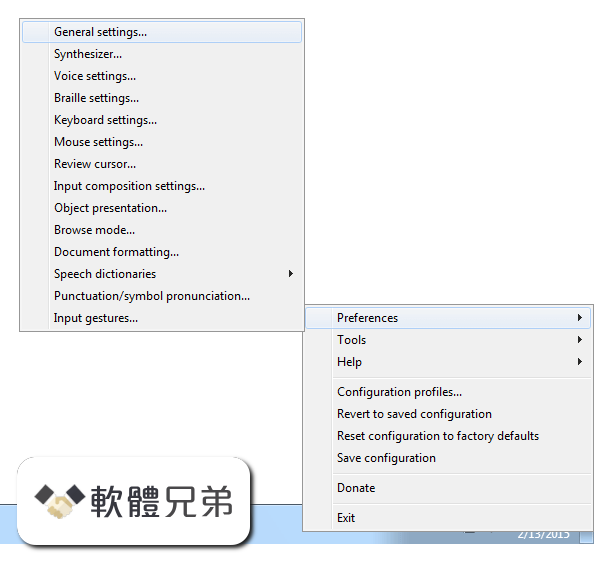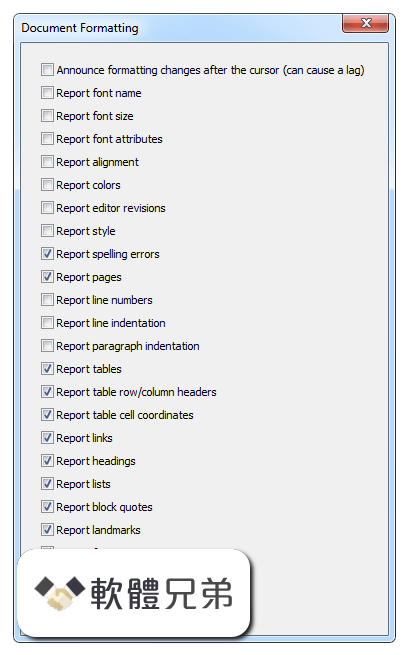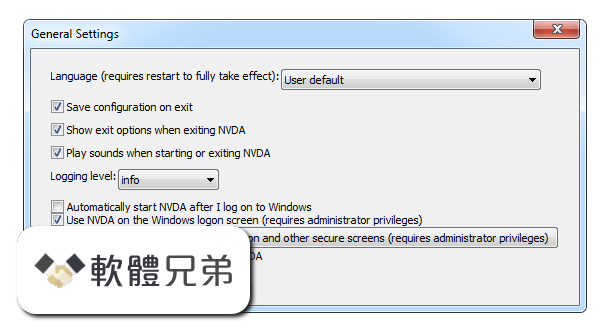|
What's new in this version: New Features
- Official support for 64 bit editions of Windows! (#309)
- Added a synthesizer driver for the Newfon synthesizer. Note that this requires a special version of Newfon. (#206)
- In virtual buffers, focus mode and browse mode can now be reported using sounds instead of speech. This is enabled by default. It can be configured from the Virtual buffers dialog. (#244)
- NVDA no longer cancels speech when volume control keys are pressed on the keyboard, allowing the user to change the volume and listen to actual results immediately. (#287)
- Completely rewritten support for Microsoft Internet Explorer and Adobe Reader documents. This support has been unified with the core support used for Mozilla Gecko, so features such as fast page rendering, extensive quick navigation, links list, text selection, auto focus mode and braille support are now available with these documents.
- Improved support for the date selection control found in the Windows Vista Date / Time properties dialog.
- improved support for the Modern XP/Vista start menu (specifically the all programs, and places menus). Appropriate level information is now announced.
- The amount of text that is announced when moving the mouse is now configurable from the Mouse settings dialog. A choice of paragraph, line, word or character can be made.
- announce spelling errors under the cursor in Microsoft Word.
- support for the Microsoft Word 2007 spell checker. Partial support may be available for prior Microsoft Word versions.
- Better support for Windows Live Mail. Plain text messages can now be read and both the plain text and HTML message composers are useable.
- In Windows Vista, if the user moves to the secure desktop (either because a UAC control dialog appeared, or because control+alt+delete was pressed), NVDA will announce the fact that the user is now on the secure desktop.
- NVDA can announce text under the mouse within dos console windows.
- Support for UI Automation via the UI Automation client API available in Windows 7, as well as fixes to improve the experience of NVDA in Windows 7.
- NVDA can be configured to start automatically after you log on to Windows. The option is in the General Settings dialog.
- NVDA can read secure Windows screens such as the Windows logon, control+alt+delete and User Account Control (UAC) screens in Windows XP and above. Reading of the Windows logon screen can be configured from the General Settings dialog. (#97)
- Added a driver for the Optelec ALVA BC6 series braille displays.
- When browsing web documents, you can now press n and shift+n to skip forward and backward past blocks of links, respectively.
- When browsing web documents, ARIA landmarks are now reported, and you can move forward and backward through them using d and shift+d, respectively. (#192)
- The Links List dialog available when browsing web documents has now become an Elements List dialog which can list links, headings and landmarks. Headings and landmarks are presented hierarchically. (#363)
- The new Elements List dialog contains a "Filter by" field which allows you to filter the list to contain only those items including the text that was typed. (#173)
- Portable versions of NVDA now look in the 'userConfig' directory inside the NVDA directory, for the user's configuration. Like for the installer version, this keeps the user's configuration separate from NVDA itself.
- Custom app modules, braille display drivers and synth drivers can now be stored in the user's configuration directory. (#337)
- Virtual buffers are now rendered in the background, allowing the user to interact with the system to some extent during the rendering process. The user will be notified that the document is being rendered if it takes longer than a second.
- If NVDA detects that it has frozen for some reason, it will automatically pass all keystrokes through so that the user has a better chance of recovering the system.
- Support for ARIA drag and drop in Mozilla Gecko. (#239)
- The document title and current line or selection is now spoken when you move focus inside a virtual buffer. This makes the behaviour when moving focus into virtual buffers consistent with that for normal document objects. (#210)
- In virtual buffers, you can now interact with embedded objects (such as Adobe Flash and Sun Java content) by pressing enter on the object. If it is accessible, you can then tab around it like any other application. To return focus to the document, press NVDA+space. (#431)
- In virtual buffers, o and shift+o move to the next and previous embedded object, respectively.
- NVDA can now fully access applications running as administrator in Windows Vista and later. You must install an official release of NVDA for this to work. This does not work for portable versions and snapshots. (#397)
Changes:
- NVDA no longer announces "NVDA started" when it starts.
- The startup and exit sounds are now played using NVDA's configured audio output device instead of the Windows default audio output device. (#164)
- Progress bar reporting has been improved. Most notably you can now configure NVDA to announce via both speech and beeps at the same time.
- Some generic roles, such as pane, application and frame, are no longer reported on focus unless the control is unnamed.
- The review copy command (NVDA+f10) copies the text from the start marker up to and including the current review position, rather than excluding the current position. This allows the last character of a line to be copied, which was not previously possible. (#430)
- the navigatorObject_where script (ctrl+NVDA+numpad5) has been removed. This key combination did not work on some keyboards, nore was the script found to be that useful.
- the navigatorObject_currentDimentions script has been remapped to NVDA+numpadDelete. The old key combination did not work on some keyboards. This script also now reports the width and height of the object instead of the right/bottom coordinates.
- Improved performance (especially on netbooks) when many beeps occur in quick succession; e.g. fast mouse movement with audio coordinates enabled. (#396)
- The NVDA error sound is no longer played in release candidates and final releases. Note that errors are still logged.
Bug Fixes:
- When NVDA is run from an 8.3 dos path, but it is installed in the related long path (e.g. progra~1 verses program files) NVDA will correctly identify that it is an installed copy and properly load the user's settings.
- speaking the title of the current foreground window with nvda+t now works correctly when in menus.
- braille no longer shows useless information in its focus context such as unlabeled panes.
- stop announcing some useless information when the focus changes such as root panes, layered panes and scroll panes in Java or Lotus applications.
- Make the keyword search field in Windows Help (CHM) viewer much more usable. Due to buggyness in that control, the current keyword could not be read as it would be continually changing.
- report correct page numbers in Microsoft Word if the page numbering has been specifically offset in the document.
- Better support for edit fields found in Microsoft Word dialogs (e.g. the Font dialog). It is now possible to navigate these controls with the arrow keys.
- better support for Dos consoles. specifically: NVDA can now read the content of particular consoles it always used to think were blank. Pressing control+break no longer terminates NVDA.
- On Windows Vista and above, the NVDA installer now starts NVDA with normal user privileges when requested to run NVDA on the finish screen.
- Backspace is now handled correctly when speaking typed words. (#306)
- Don't incorrectly report "Start menu" for certain context menus in Windows Explorer/the Windows shell. (#257)
- NVDA now correctly handles ARIA labels in Mozilla Gecko when there is no other useful content. (#156)
- NVDA no longer incorrectly enables focus mode automatically for editable text fields which update their value when the focus changes; e.g. http://tigerdirect.com/. (#220)
- NVDA will now attempt to recover from some situations which would previously cause it to freeze completely. It may take up to 10 seconds for NVDA to detect and recover from such a freeze.
- When the NVDA language is set to "User default", use the user's Windows display language setting instead of the Windows locale setting. (#353)
- NVDA now recognises the existence of controls in AIM 7.
- The pass key through command no longer gets stuck if a key is held down. Previously, NVDA stopped accepting commands if this occurred and had to be restarted. (#413)
- The taskbar is no longer ignored when it receives focus, which often occurs when exiting an application. Previously, NVDA behaved as if the focus had not changed at all.
- When reading text fields in applications which use the Java Access Bridge (including OpenOffice.org), NVDA now functions correctly when reporting of line numbers is enabled.
- The review copy command (NVDA+f10) gracefully handles the case where it is used on a position before the start marker. Previously, this could cause problems such as crashes in Notepad++.
- A certain control character (0x1) no longer causes strange eSpeak behaviour (such as changes in volume and pitch) when it is encountered in text. (#437)
- The report text selection command (NVDA+shift+upArrow) now gracefully reports that there is no selection in objects which do not support text selection.
- Fixed the issue where pressing the enter key on certain Miranda-IM buttons or links was causing NVDA to freeze. (#440)
- The current line or selection is now properly respected when spelling or copying the current navigator object.
- Worked around a Windows bug which was causing garbage to be spoken after the name of link controls in Windows Explorer and Internet Explorer dialogs. (#451)
- Fixed a problem with the report date and time command (NVDA+f12). Previously, date reporting was truncated on some systems. (#471)
- Fixed the issue where the system screen reader flag was sometimes inappropriately cleared after interacting with secure Windows screens. This could cause problems in applications which check the screen reader flag, including Skype, Adobe Reader and Jart. (#462)
- In an Internet Explorer 6 combo box, the active item is now reported when it is changed. (#342)
NVDA 2009.1 相關參考資料
2009.1 Milestone
NVDA, the free and open source Screen Reader for Microsoft Windows - 2009.1 Milestone · nvaccess/nvda.
https://github.com
Downloading NVDA 2009.1 from FileHorse.com
NVDA (NonVisual Desktop Access) is a free “screen reader” which enables blind and vision-impaired people to use computers. It reads the text on the screen ...
https://www.filehorse.com
Index of filesnvdareleases2009.1rc1 - NV Access
Index of /files/nvda/releases/2009.1rc1/ ../ nvda_2009.1rc1_changes.txt 11-Feb-2015 07:50 48134.
https://www.nvaccess.org
NonVisual Desktop Access
NonVisual Desktop Access (NVDA) is a free and open-source, portable screen reader for Microsoft Windows. The project was started by Michael Curran in 2006.
https://en.wikipedia.org
NVDA 2009.1 Download
2009年11月24日 — Download NVDA 2009.1 for Windows PC from FileHorse. 100% Safe and Secure ✓ Free Download (32-bit/64-bit) Software Version.
https://www.filehorse.com
NVDA 2009.1 Portable (not completely portable) Development ...
Description: Providing feedback via synthetic speech and Braille, NVDA allows blind and vision impaired people to access and interact with the Windows operating ...
https://portableapps.com
NVDA 2009.1beta1 - Download
NVDA 2009.1beta1 is a Shareware software in the category Miscellaneous developed by nvda-project.org. The latest version of NVDA 2009.1beta1 is currently ...
https://nvda-2009-1beta1.updat
Slides and Notes for - EASI
NVDA 2009.1 Highlights. NVDA 2010.1 Highlights. Why use NVDA? Why NVDA? - The Cost Factor. Why NVDA? - Public Access. Why NVDA? - Supporting Others. Why NVDA ...
http://easi.cc
[轉貼] NVDA 2009.1 Beta1推出- 看板blind_pc - 批踢踢實業坊
NVDA在10月初已經推出2009.1 Beta1測試版,這是為日後推出2009.1正式版所作的準備。有興趣的用戶可以到nvda-project.org 下載測試軟件並向開發者會報程式錯誤、問題 ...
https://www.ptt.cc
|





